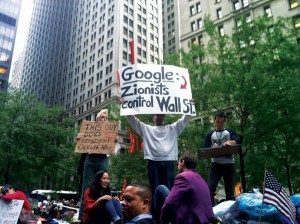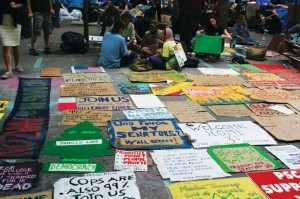Just about every day since the start of the Occupy Wall Street demonstration at Zuccotti Park, a middle-aged homeless man sporting a baseball cap and ripped jeans has been joining protesters to show his disdain for corporate greed and the economic elite.  But he has a different message than most of the other demonstrators, and it is written on his signs for all to read. Though varying day-to-day, the slogans generally revolve around one central theme: Jews control Wall Street.
But he has a different message than most of the other demonstrators, and it is written on his signs for all to read. Though varying day-to-day, the slogans generally revolve around one central theme: Jews control Wall Street.
It is a message with which few others seem to agree. However, in the midst of a crowd that celebrates free speech, there is not much those who find his message distasteful can do to express their opposition to his message. Some fear that his signs could be misconstrued by bystanders or shown in the media as representative of the movement at large. Already, a number of media outlets and blogs have called out Occupy Wall Street for anti-Semitism and violence, among other things.
It outlines one of Occupy Wall Street’s major problems: how to deal with the many controversial and often counter-productive messages in an ungoverned environment that encourages people to express their own grievances.
“It’s difficult,” explained Eric Spielman, 34, from Portland, “because we want it to remain peaceful and as an open forum for anyone to speak.”
But it is not just anti-Semitic remarks that have carved a niche at Zuccotti Park. Among the diverse group of protesters are revolutionary communists, anarchists, libertarians, democrats, hippies, punks, 9/11 Truthers, hackers, union members, followers of Lyndon LaRouche and people advocating for an end to the Federal Reserve.
Jeff Smith, who has been involved with Occupy Wall Street since day one, said that the real message of the demonstration remains clear for those who take part.
“We don’t try to control the message here,” Smith said, adding that censorship would defeat the purpose of the movement. “But those kinds of people [with hateful messages] kind of get naturally ostracized.”
By and large, those advocating disagreeable messages are neglected and left to the sidelines. Occasionally, they are confronted with hostility and debate. A video recently surfaced on YouTube of a crowd of protesters yelling their condemnation at the anti-Semitic sign-holder.
Yet most demonstrators do not find it to be much of a problem.
“If we have 3,000 people, and one guy with his anti-Semitic message, you would really have to look for that to find it,” said Occupy Wall Street press spokesman Marc Lombardo. “We put our own voices on the floor and drown them out.”
However, the remarks of individuals have been used by some in the media and made to appear representative of the movement, especially within the blogosphere. Recently, Fox News aired a video showing a protester arguing with a Jewish man sporting a yarmulke. The Occupy Wall Street protester lashes out, “You are a bum, Jew… Go back to Israel!”
In another case, a hacker from the group Anonymous posted the personal information of Anthony Bologna — the NYPD officer responsible for pepper spraying a group of female protesters — warning, “Before you commit atrocities against innocent people, think twice. WE ARE WATCHING!!! Expect Us!”
Though many protesters and civil liberties organizations would like to see Bologna prosecuted for his excessive use of force, many disagreed with the invasive tactics of the Anonymous hacker. Occupy Wall Street’s General Assembly had already decided not to release his personal information to the public.
More recently, a video surfaced on YouTube showing a protester at Occupy Los Angeles covering his face with a bandanna and telling protesters to take up violence. He calls Mahatma Gandhi a “tumor” and says that pacifism has failed. Instead, he encourages protesters to follow the bloody path of the French Revolution.
However, much of the Occupy Wall Street coverage has revolved around how welcoming and inclusive the environment has become. “These protests bring people together,” said protester Eric Spielman, 34. But Spielman agreed that it is difficult to maintain a focused message while trying to keep an open space for people to voice their grievances.
Joey Pearson, who traveled from afar to join Occupy Wall Street, felt that it is not the role of the General Assembly to address such issues, and did not feel that unrepresentative messages pose a real problem. However, he felt that it is the role of individual protesters to refute such claims.
“If you don’t like that guy holding that sign, you should hold another [protest] to counter it,” he said.







Leave a Reply